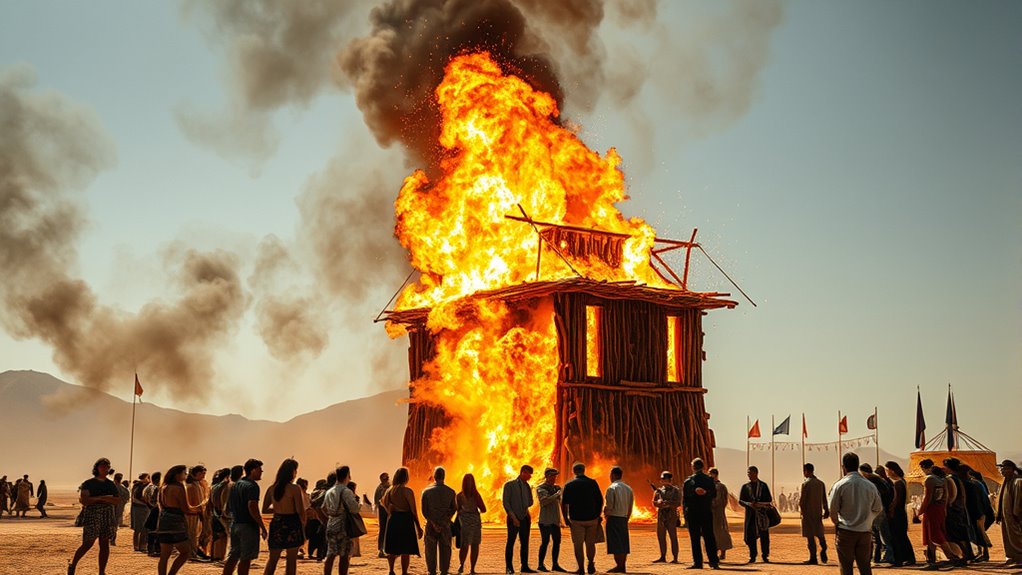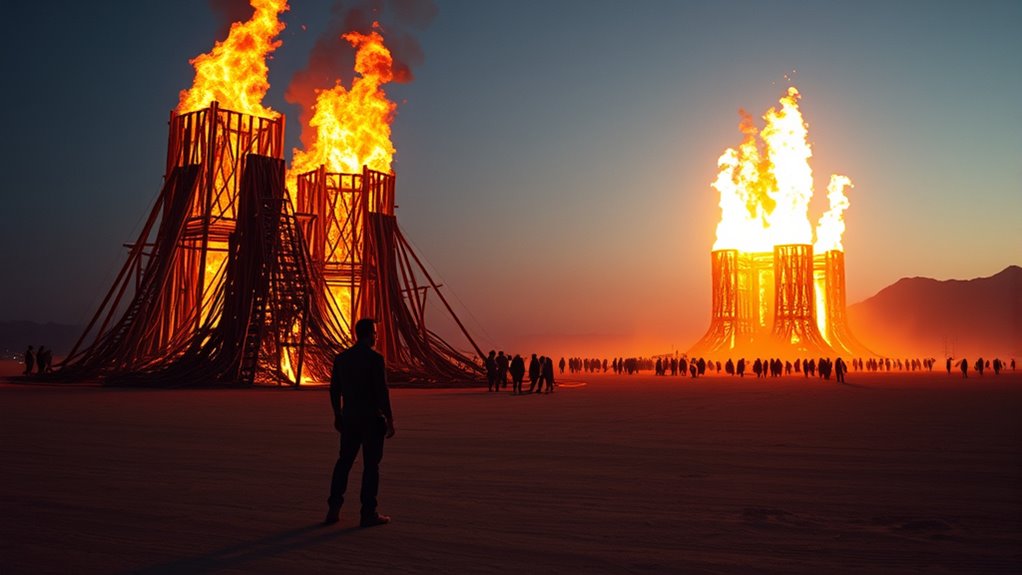The Temple Burn and Man Burn serve distinct purposes at Burning Man: the Man Burn celebrates community, self-expression, and letting go of ego, while the Temple Burn offers a sacred space for reflection, mourning, and personal remembrance. During the Man Burn, you can join the festivities with fireworks and music, but should avoid interfering with the fire. For the Temple Burn, approach quietly, respect personal tokens, and skip photos. Understanding these differences helps you participate respectfully and meaningfully—discover more about their unique meanings and etiquette.
Key Takeaways
- Man Burn celebrates community, self-expression, and release of ego through a large wooden sculpture, while the Temple Burn honors personal tokens and reflection.
- Man Burn is lively with fireworks and music; the Temple Burn is quiet, reverent, emphasizing mourning and remembrance.
- During Man Burn, participants should enjoy the spectacle safely without interference; during the Temple Burn, maintain silence and respect personal sacred objects.
- The Man Burn fosters collective celebration and energetic expression; the Temple Burn provides a space for personal emotional release and reflection.
- Proper etiquette involves respecting fire boundaries at the Man Burn and maintaining reverence and privacy during the Temple Burn.

Every year at Burning Man, the spectacle of the Temple Burn and the Man Burn captures the community’s imagination, but they serve markedly different purposes. You’ll notice that while both involve large-scale burns, their meanings and the way you’re expected to behave differ considerably. Understanding these differences helps you honor the spirit of the event and participate meaningfully in the rituals.
The Man Burn is the more famous of the two. It’s a massive wooden sculpture, usually around 40 feet tall, representing the “Man” figure that has been a central symbol of Burning Man since its inception. As you witness the burn, you should see it as a celebration of community, creativity, and radical self-expression. The event is lively, energetic, and often filled with music, fire dancers, and fireworks. It’s a moment of collective release, where people gather to watch the Man ignite and burn, symbolizing letting go of ego, attachment, and material concerns. While it’s an exhilarating experience, it’s essential to approach it with respect. You shouldn’t interfere with the burn or get too close to the fire, and you should remain mindful of safety protocols. The focus is on collective participation, so keep your attention on the spectacle and the community sharing it with you.
On the other hand, the Temple Burn carries a more somber and personal significance. The Temple is an intricate structure, often adorned with personal tokens, memorials, and messages from participants. It’s a sacred space for reflection, mourning, and release. When the temple is set for burning, you’re encouraged to approach with reverence. Many people spend time beforehand writing or leaving behind tokens of what they wish to let go, and you should respect those intentions. During the burn, maintain a quiet demeanor and show empathy for others who might be experiencing emotional moments. It’s not a celebration but rather a communal act of honoring loss, transformation, and hope. You should avoid taking photos during the burn to preserve the sacred atmosphere and respect the privacy of those mourning or reflecting.
Both burns are powerful rituals, but they serve different emotional and spiritual purposes. The Man Burn is about exuberant release and community celebration, while the Temple Burn is about reflection, remembrance, and personal meaning. By understanding and respecting these distinctions, you help uphold the integrity of Burning Man’s values. Approach each with the appropriate mindset, and you’ll find that both rituals deepen your connection to the event and its community.
Additionally, understanding the residency requirements and safety protocols can enhance your experience and ensure respectful participation in these rituals.
Frequently Asked Questions
Are There Age Restrictions for Participating in Temple or Man Burns?
You can participate in temple and man burns regardless of age, but minors should have permission from a parent or guardian. Always respect safety guidelines and follow event rules. If you’re under 18, check with event organizers beforehand to make certain you’re allowed to partake. Remember, the focus is on community and respect, so approach with mindfulness and adhere to any age-related restrictions or etiquette to keep everyone safe and respectful.
What Safety Precautions Are Recommended During the Burns?
The flames can swallow you whole if you’re not careful, so safety is vital. Always wear fire-resistant clothing, keep a fire extinguisher nearby, and stay sober to stay alert. Follow event guidelines, listen to experienced burners, and never attempt to burn alone. Hydrate well, protect your skin, and respect the fire’s power. These precautions guarantee you enjoy the experience safely and honor the sacred tradition.
Can Spectators Watch Without Participating in the Burns?
Yes, you can watch without participating in the burns. Many spectators attend to witness the spectacle and experience the atmosphere, but it’s important to stay respectful and follow event guidelines. Keep a safe distance, avoid interfering with the burn process, and respect participants’ space. Be mindful of safety barriers and listen to event staff instructions to ensure everyone’s safety and enjoyment during the event.
How Are Participants Selected for the Burns?
Participants are usually selected through a combination of pre-registration, volunteer sign-ups, or specific event roles. Sometimes, organizers choose individuals based on their commitment, contribution, or connection to the community. If you want to take part, check the event’s official channels for application details and deadlines. Be prepared to follow safety guidelines and demonstrate your understanding of the burn’s spirit and etiquette before being officially chosen.
Are There Specific Dress Codes for Attendees at These Events?
You don’t need a strict dress code to attend, but wearing respectful, comfortable, and festival-appropriate attire helps you blend in and honor the spirit. Avoid overly commercial or provocative clothing, as these can feel out of place. Embrace creativity with your outfit, but remember, the focus is on community and self-expression. When you dress thoughtfully, you connect more deeply with the experience and respect the event’s meaning.
Conclusion
So, now you know the difference between a temple burn and a man burn—one’s a fiery spectacle of tradition, the other’s a tragic misunderstanding. Remember, if you’re ever tempted to burn a man, maybe just stick to the temple instead. After all, burning people might get you on a list you don’t want to be on. Keep it respectful, keep it safe, and let the flames of tradition do their thing—just don’t get carried away!










